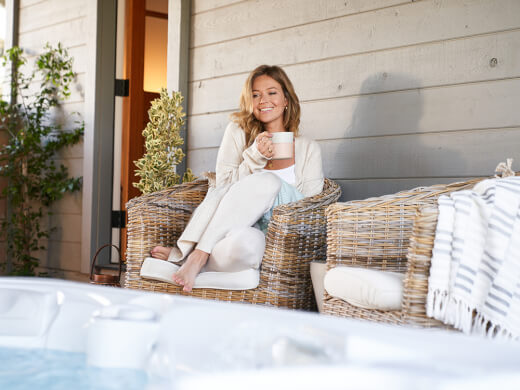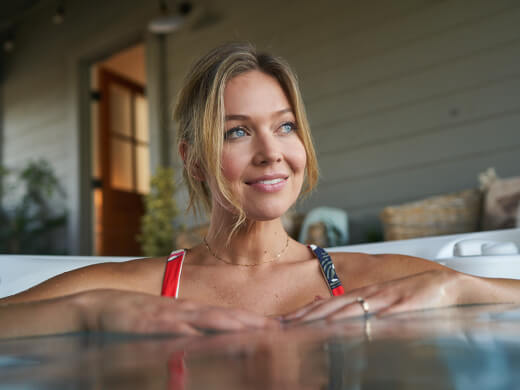A Guide to Preparing and Using Your Hot Tub for the Winter
Winter is one of the best times of year to own a hot tub, especially if you live in an area with a colder climate. Imagine enjoying a lovely vista of snow-covered trees and mountains behind the steam rising from the warm water of your spa. While that probably sounds delightful, winter does come with challenges, and one of those is keeping your hot tub and its components from freezing. This guide walks through the basic steps of hot tub winterization, but you should always consult your Caldera Spas owner's manual for details on winterizing your model.
Browse to one of our quick link sections below:
- Determine if You Need to Winterize Your Hot Tub
- What You Need to Prepare for Winter
- Steps to Winterize Your Hot Tub
- How to Care for Your Spa While on Vacation
- Hot Tub Winter Maintenance Tips
- Using a Hot Tub in Winter
- Best Temperature for Hot Tubs in Winter
- How to Keep your Hot Tub Pipes From Freezing
1. Determine if You Need to Winterize Your Hot Tub
If you're going to be at home most of the winter, you might not want (or need) to go through the trouble of winterizing your spa, which simply means shutting it down while you're away or not using it. Closing your spa for the season means you won't be able to enjoy a warm soak on a cold winter's night, and you'll miss out on all of the wellness benefits your hot tub provides. But if your spa sits at a summer vacation home where you won't return to it until spring or if you travel for a couple of weeks during the winter, winterizing will protect your investment.
If, however, your plans include only a short vacation of a week or so, winterizing isn't necessary. The Caldera Spas app can give you peace of mind while you're away. The app allows you to check and control your hot tub settings remotely, and even lock your spa from far away. You can also add guest users to conveniently allow others to monitor your spa when you can't.
Ready to winterize your spa? Get started here.
Don't need to winterize? Get the most of your hot tub with these cold weather tips.
2. What You Need to Prepare for Winter
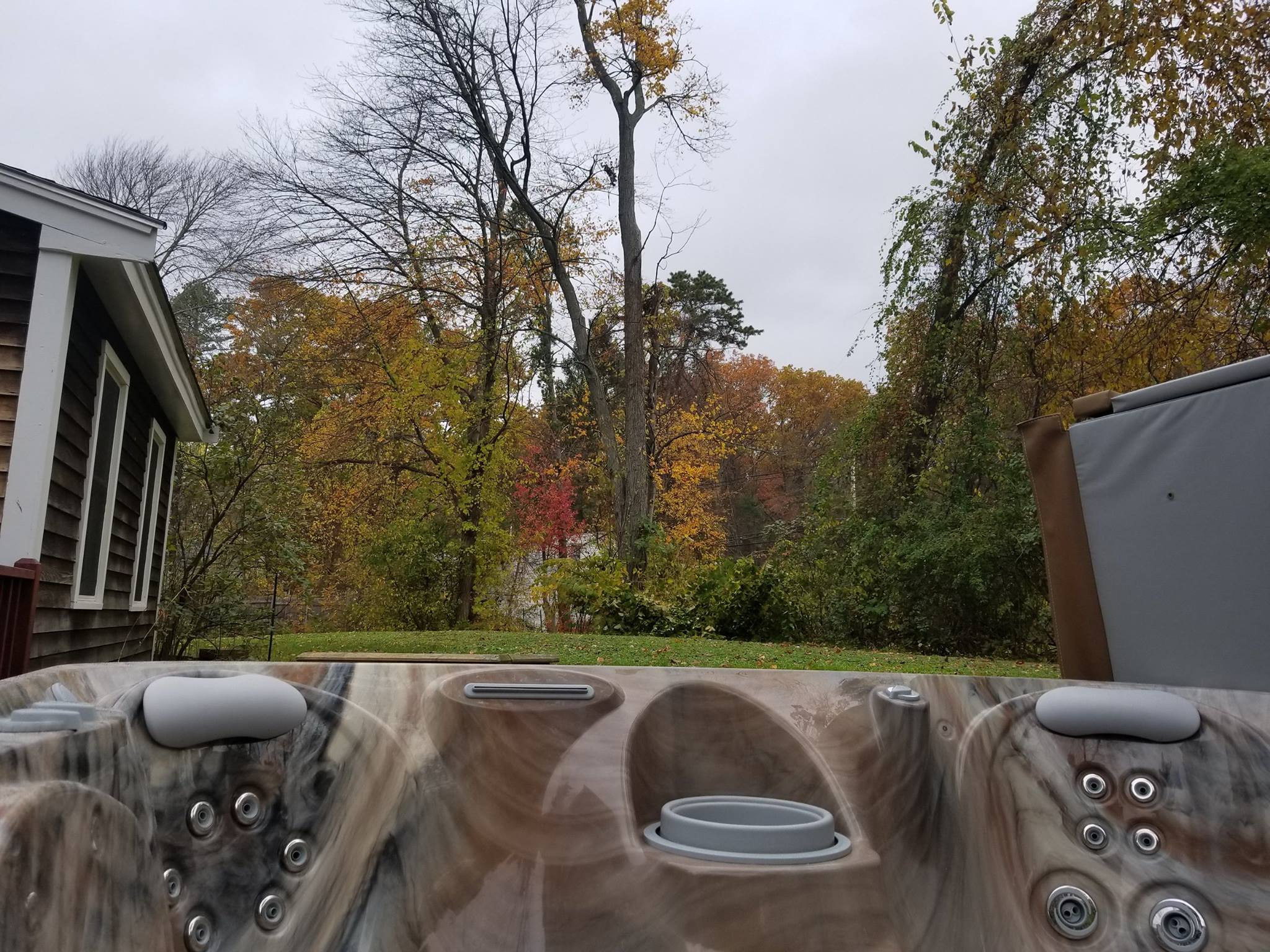
Winterizing your spa should happen before temperatures drop below freezing. Draining the water while temperatures are still relatively warm will ensure that trace amounts don't freeze in the spa or its pipes afterward.
To winterize your spa, you'll need the following equipment:
- A garden hose to direct the water you drain.
- A wet/dry vacuum cleaner to remove residual water from the bottom of the spa and its pipes.
- Towels or rags to thoroughly clean and dry the shell, seats, and bar top.
- Propylene Glycol, a non-toxic antifreeze, to prevent spa pipes and machinery from freezing.
- A funnel(s) for directing the antifreeze you pour into hard-to-reach openings.
- Optional: Two pieces of plywood longer than the width of your spa.
Stagnant water can allow for the growth of bacteria and algae. In order to avoid microbes lingering in the piping of a dormant spa, make sure the water is clean before you drain it. It's a good idea to use draining a hot tub for winter as a chance to clean the shell, bar top, and filters too as this will make refilling it quicker when you return.
3. Steps to Winterize Your Hot Tub
Follow these steps to properly winterize your spa before the colder months. You can also refer to your Caldera Spas owner's manual for more detailed instructions.
-
Let the chemicals in your water break down.
The first thing to do in the winterizing process is let the existing chemicals in the spa water break down, which typically takes 3-4 days. You'll know you're ready to move on to the next step when the chlorine on the test strip reads 0. -
Turn off the power to your hot tub.
Find the circuit breaker box near the tub and turn the GFCI breakers to the off position. Since this is a long-term shut down, you may wish to turn the circuit breaker on your home's main panel off as well. If you cannot find these breakers contact your local dealer or electrician for assistance. -
Drain the spa water.
Unscrew your hot tub's drainage plug and attach the garden hose. Place the far end of the hose in a place where the water can safely drain away from your home's foundation. If you have a submersible pump, you can use it to speed up this process. -
Remove filters, cartridges and accessories.
Remove, clean, and dry filters, and then store them in a warm, dry place. If your spa has detachable pillows and spa-side accessories, remove and store them as well. Discard any chemical cartridges in the spa. -
Remove remaining water.
Once the water has stopped flowing from the hose, there may still be several gallons left inside the spa that can freeze and cause damage. Use the wet/dry vacuum to remove water remaining in the bottom of the tub and from the jets, filter standpipe, and any other openings in the hot tub. -
Add antifreeze.
Replace the spa's drain cap, and then dilute the antifreeze as directed on the bottle. Using the funnel, pour a small amount of antifreeze into jet openings, the filter standpipe, and water feature orifices. -
Clean the spa.
Use towels or rags to clean the shell, bar top, and other spa surfaces with approved cleaners. -
Cover your hot tub.
Place your hot tub cover back on the spa and securely latch it in place. Optional step: Place two pieces of plywood across the top of your spa cover to prevent damage that might occur by accumulated snow, and then cover with a tarp.
4. How to Take Care of Your Spa While on Vacation
If you're embarking on a winter getaway, make sure your hot tub is still being monitored. Some people ask a friend to stop by on a regular basis. However, a more convenient option is using the Caldera Spas app, powered by the Connected Spa Kit. This gives you the option to keep an eye on your hot tub using your smartphone. The app provides real-time monitoring of key spa functions and also sends alerts when attention is needed.
Even if you do take advantage of the app, you may still want to enlist a friend as a back-up in certain situations. In the event of a lengthy power outage, for example, it's worth having a friend you can call who knows how to drain your hot tub and remove water from all pipes and openings.
5. Hot Tub Winter Maintenance Tips
To keep your tranquil retreat in good working order, basic maintenance is an important component of winterizing. Here are a few things to keep in mind.
-
Replace worn or damaged hot tub covers.
When you're winterizing your hot tub, don't neglect the cover. This does a lot more than keep dirt and debris from getting into the water when you're not using it. Hot tub covers are custom fitted and filled with high density insulation, designed to form a tight seal and keep heat from escaping. When the seal and insulation are working as they should, the water maintains its temperature longer and helps you conserve energy. So, replacing a cracked, torn or damaged cover isn't just a cosmetic fix. It will keep energy costs low and keep your hot tub from overworking. -
Keep snow and ice out of your winterized spa.
While replacing a worn cover can improve a spa's insulation and keep costs down, there are a few additional things you can do to keep snow and ice out of your spa and make sure your spa is protected all winter long.- Close the cover and fasten the tie-downs.
- Place plywood on the spa cover (longer than the spa width). This will evenly distribute the weight of any snow and ice.
- Finally, secure a plastic sheet or tarp over the top.
-
Monitor the temperature.
Set a reminder to check the water temperature daily; you can do this manually or through your Caldera Spas app. This will provide peace of mind that everything's working properly, while giving you time to react should something go wrong. -
Monitor the water level.
The water in your hot tub will evaporate much more quickly during cold, dry weather. Keep an eye on the water level, and make sure it doesn't fall below the skimmer level. If this happens, the water can't circulate and won't be heated.
6. Using a Hot Tub in Winter
Like any time of year, winter is a time where you'll want to be mindful of keeping the water clean and well-balanced. Stick to this basic routine and your hot tub will be ready to help you warm up from the chilly winter temperatures.
-
Adjust your water care based on usage.
Clean, balanced water will ensure your hot tub is ready to enjoy whenever the mood strikes. Prepare for the winter months by adjusting your water care. This varies by the type of system you have.FreshWater® Salt System:
This system makes water maintenance quite simple throughout the year, sanitizing water by using a disposable cartridge to generate chlorine from salt. These cartridges last four months which means you'll spend less time on maintenance during the cold temperatures and more time enjoying your spa.
Learn MoreThe FreshWater Smart Monitoring System:
This system works with the FreshWater Salt System to regularly test your water every hour and indicate when adjustments are needed for pH, chlorine and salt levels, helping you maintain clean, balanced spa water.
Learn More -
Rinse off before getting in your hot tub.
Clean skin is key to maintaining clean spa water. While it may be tempting to slip into the hot tub without showering, lotion and soap residues left on the skin (along with any other unwanted substances) can negatively impact your water balance. You don't have to take a full shower; just a quick rinse will do the trick. (Tip: When laundering your swimsuit, try using less laundry detergent followed by a thorough rinse. This will also prevent soap residue from seeping into your spa water.) -
Designate a hot tub swimsuit.
Similar to the residues that can transfer from your skin, your swimsuit can hold on to sunscreens, lotions, and laundry detergent residue, which can then be transferred to the water. If you can, designate one of your swimsuits as a “hot tub-only" suit and avoid washing it with traditional laundry soap. If possible, simply rinse it thoroughly after each soak or run it through the washing machine without soap. If you prefer to use detergent or soap, use as little as possible to avoid residue. -
Drain and refill at the right time.
Draining a hot tub can be a challenge in the cold winter months. Depending on your water care system, you might be able to wait longer between draining your hot tub. If you do find that your tub does need a drain and refill, save it for a day when temperatures will be above freezing for several hours after you perform the task. Also, if you live in an area with high calcium hardness in the water (also known as hard water), be sure to use Vanishing Act® calcium remover. This will reduce mineral buildup on hot tub surfaces as well as water lines. Your local dealer should have this product on hand, and if not, they should be able to order it.
7. Best Temperature for Hot Tubs in Winter
If you intend to use your hot tub regularly during the winter, you can keep the water at the same temperature you do throughout the other seasons. However, if you won't be using it as much (and don't need to winterize), the recommended minimum water temperature is 80°F/26°C.
8. How to Keep Your Hot Tub Pipes From Freezing
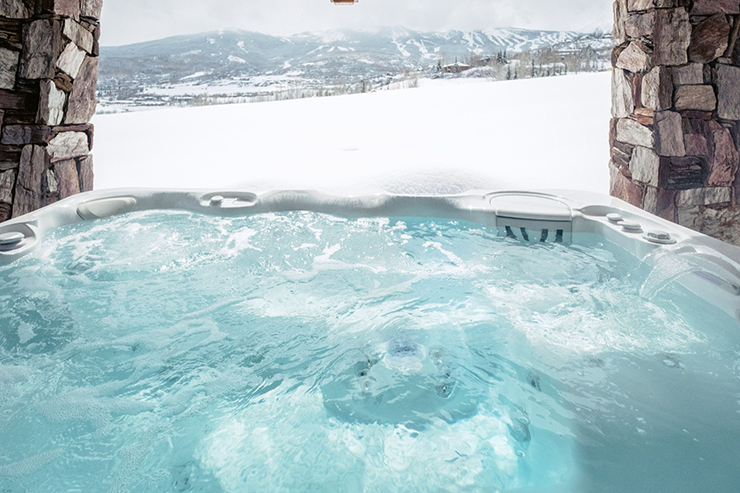
One common way to help prevent a home pipe from freezing is to open a faucet slightly to let a trickle of water flow through. Flowing water doesn't freeze as quickly as still water, and it may melt any ice starting to form in a pipe. Keeping that in mind, consider how a home hot tub is engineered.
The latest high-tech hot tubs are equipped with freeze protection — circulation jet pumps and heaters that are activated when temps drop to 40 degrees Fahrenheit to keep the water hot and flowing. The Utopia and Paradise series spas from Caldera, for instance, are equipped with an EnergyPro® circulation pump that periodically pumps the water through the filters to help keep it moving, as well as an EnergyPro® heater that keeps the water well above the freezing point.
Worry Less with a Caldera Spa
Caldera spas are engineered for reliability and everyday use, all year long. That means caring for your hot tub to keep it from freezing in winter involves very little effort. Your local Caldera Spas dealer is well-trained and available to help answer any questions you might have.
Caldera spas are sold and serviced by a global network of dealers dedicated to customer satisfaction. Enjoy the best year-round support for your hot tub or find the perfect spa to keep you warm all winter at your local Caldera dealer.
A Guide to Preparing and Using Your Hot Tub for the Winter
Winter is one of the best times of year to own a hot tub, especially if you live in an area with a colder climate. Imagine enjoying a lovely vista of snow-covered trees and mountains behind the steam rising from the warm water of your spa. While that probably sounds delightful, winter does come with challenges, and one of those is keeping your hot tub and its components from freezing. This guide walks through the basic steps of hot tub winterization, but you should always consult your Caldera Spas owner's manual for details on winterizing your model.
Browse to one of our quick link sections below:
- Determine if You Need to Winterize Your Hot Tub
- What You Need to Prepare for Winter
- Steps to Winterize Your Hot Tub
- How to Care for Your Spa While on Vacation
- Hot Tub Winter Maintenance Tips
- Using a Hot Tub in Winter
- Best Temperature for Hot Tubs in Winter
- How to Keep your Hot Tub Pipes From Freezing
1. Determine if You Need to Winterize Your Hot Tub
If you're going to be at home most of the winter, you might not want (or need) to go through the trouble of winterizing your spa, which simply means shutting it down while you're away or not using it. Closing your spa for the season means you won't be able to enjoy a warm soak on a cold winter's night, and you'll miss out on all of the wellness benefits your hot tub provides. But if your spa sits at a summer vacation home where you won't return to it until spring or if you travel for a couple of weeks during the winter, winterizing will protect your investment.
If, however, your plans include only a short vacation of a week or so, winterizing isn't necessary. The Caldera Spas app can give you peace of mind while you're away. The app allows you to check and control your hot tub settings remotely, and even lock your spa from far away. You can also add guest users to conveniently allow others to monitor your spa when you can't.
Ready to winterize your spa? Get started here.
Don't need to winterize? Get the most of your hot tub with these cold weather tips.
2. What You Need to Prepare for Winter

Winterizing your spa should happen before temperatures drop below freezing. Draining the water while temperatures are still relatively warm will ensure that trace amounts don't freeze in the spa or its pipes afterward.
To winterize your spa, you'll need the following equipment:
- A garden hose to direct the water you drain.
- A wet/dry vacuum cleaner to remove residual water from the bottom of the spa and its pipes.
- Towels or rags to thoroughly clean and dry the shell, seats, and bar top.
- Propylene Glycol, a non-toxic antifreeze, to prevent spa pipes and machinery from freezing.
- A funnel(s) for directing the antifreeze you pour into hard-to-reach openings.
- Optional: Two pieces of plywood longer than the width of your spa.
Stagnant water can allow for the growth of bacteria and algae. In order to avoid microbes lingering in the piping of a dormant spa, make sure the water is clean before you drain it. It's a good idea to use draining a hot tub for winter as a chance to clean the shell, bar top, and filters too as this will make refilling it quicker when you return.
3. Steps to Winterize Your Hot Tub
Follow these steps to properly winterize your spa before the colder months. You can also refer to your Caldera Spas owner's manual for more detailed instructions.
-
Let the chemicals in your water break down.
The first thing to do in the winterizing process is let the existing chemicals in the spa water break down, which typically takes 3-4 days. You'll know you're ready to move on to the next step when the chlorine on the test strip reads 0. -
Turn off the power to your hot tub.
Find the circuit breaker box near the tub and turn the GFCI breakers to the off position. Since this is a long-term shut down, you may wish to turn the circuit breaker on your home's main panel off as well. If you cannot find these breakers contact your local dealer or electrician for assistance. -
Drain the spa water.
Unscrew your hot tub's drainage plug and attach the garden hose. Place the far end of the hose in a place where the water can safely drain away from your home's foundation. If you have a submersible pump, you can use it to speed up this process. -
Remove filters, cartridges and accessories.
Remove, clean, and dry filters, and then store them in a warm, dry place. If your spa has detachable pillows and spa-side accessories, remove and store them as well. Discard any chemical cartridges in the spa. -
Remove remaining water.
Once the water has stopped flowing from the hose, there may still be several gallons left inside the spa that can freeze and cause damage. Use the wet/dry vacuum to remove water remaining in the bottom of the tub and from the jets, filter standpipe, and any other openings in the hot tub. -
Add antifreeze.
Replace the spa's drain cap, and then dilute the antifreeze as directed on the bottle. Using the funnel, pour a small amount of antifreeze into jet openings, the filter standpipe, and water feature orifices. -
Clean the spa.
Use towels or rags to clean the shell, bar top, and other spa surfaces with approved cleaners. -
Cover your hot tub.
Place your hot tub cover back on the spa and securely latch it in place. Optional step: Place two pieces of plywood across the top of your spa cover to prevent damage that might occur by accumulated snow, and then cover with a tarp.
4. How to Take Care of Your Spa While on Vacation
If you're embarking on a winter getaway, make sure your hot tub is still being monitored. Some people ask a friend to stop by on a regular basis. However, a more convenient option is using the Caldera Spas app, powered by the Connected Spa Kit. This gives you the option to keep an eye on your hot tub using your smartphone. The app provides real-time monitoring of key spa functions and also sends alerts when attention is needed.
Even if you do take advantage of the app, you may still want to enlist a friend as a back-up in certain situations. In the event of a lengthy power outage, for example, it's worth having a friend you can call who knows how to drain your hot tub and remove water from all pipes and openings.
5. Hot Tub Winter Maintenance Tips
To keep your tranquil retreat in good working order, basic maintenance is an important component of winterizing. Here are a few things to keep in mind.
-
Replace worn or damaged hot tub covers.
When you're winterizing your hot tub, don't neglect the cover. This does a lot more than keep dirt and debris from getting into the water when you're not using it. Hot tub covers are custom fitted and filled with high density insulation, designed to form a tight seal and keep heat from escaping. When the seal and insulation are working as they should, the water maintains its temperature longer and helps you conserve energy. So, replacing a cracked, torn or damaged cover isn't just a cosmetic fix. It will keep energy costs low and keep your hot tub from overworking. -
Keep snow and ice out of your winterized spa.
While replacing a worn cover can improve a spa's insulation and keep costs down, there are a few additional things you can do to keep snow and ice out of your spa and make sure your spa is protected all winter long.- Close the cover and fasten the tie-downs.
- Place plywood on the spa cover (longer than the spa width). This will evenly distribute the weight of any snow and ice.
- Finally, secure a plastic sheet or tarp over the top.
-
Monitor the temperature.
Set a reminder to check the water temperature daily; you can do this manually or through your Caldera Spas app. This will provide peace of mind that everything's working properly, while giving you time to react should something go wrong. -
Monitor the water level.
The water in your hot tub will evaporate much more quickly during cold, dry weather. Keep an eye on the water level, and make sure it doesn't fall below the skimmer level. If this happens, the water can't circulate and won't be heated.
6. Using a Hot Tub in Winter
Like any time of year, winter is a time where you'll want to be mindful of keeping the water clean and well-balanced. Stick to this basic routine and your hot tub will be ready to help you warm up from the chilly winter temperatures.
-
Adjust your water care based on usage.
Clean, balanced water will ensure your hot tub is ready to enjoy whenever the mood strikes. Prepare for the winter months by adjusting your water care. This varies by the type of system you have.FreshWater® Salt System:
This system makes water maintenance quite simple throughout the year, sanitizing water by using a disposable cartridge to generate chlorine from salt. These cartridges last four months which means you'll spend less time on maintenance during the cold temperatures and more time enjoying your spa.
Learn MoreThe FreshWater Smart Monitoring System:
This system works with the FreshWater Salt System to regularly test your water every hour and indicate when adjustments are needed for pH, chlorine and salt levels, helping you maintain clean, balanced spa water.
Learn More -
Rinse off before getting in your hot tub.
Clean skin is key to maintaining clean spa water. While it may be tempting to slip into the hot tub without showering, lotion and soap residues left on the skin (along with any other unwanted substances) can negatively impact your water balance. You don't have to take a full shower; just a quick rinse will do the trick. (Tip: When laundering your swimsuit, try using less laundry detergent followed by a thorough rinse. This will also prevent soap residue from seeping into your spa water.) -
Designate a hot tub swimsuit.
Similar to the residues that can transfer from your skin, your swimsuit can hold on to sunscreens, lotions, and laundry detergent residue, which can then be transferred to the water. If you can, designate one of your swimsuits as a “hot tub-only" suit and avoid washing it with traditional laundry soap. If possible, simply rinse it thoroughly after each soak or run it through the washing machine without soap. If you prefer to use detergent or soap, use as little as possible to avoid residue. -
Drain and refill at the right time.
Draining a hot tub can be a challenge in the cold winter months. Depending on your water care system, you might be able to wait longer between draining your hot tub. If you do find that your tub does need a drain and refill, save it for a day when temperatures will be above freezing for several hours after you perform the task. Also, if you live in an area with high calcium hardness in the water (also known as hard water), be sure to use Vanishing Act® calcium remover. This will reduce mineral buildup on hot tub surfaces as well as water lines. Your local dealer should have this product on hand, and if not, they should be able to order it.
7. Best Temperature for Hot Tubs in Winter
If you intend to use your hot tub regularly during the winter, you can keep the water at the same temperature you do throughout the other seasons. However, if you won't be using it as much (and don't need to winterize), the recommended minimum water temperature is 80°F/26°C.
8. How to Keep Your Hot Tub Pipes From Freezing

One common way to help prevent a home pipe from freezing is to open a faucet slightly to let a trickle of water flow through. Flowing water doesn't freeze as quickly as still water, and it may melt any ice starting to form in a pipe. Keeping that in mind, consider how a home hot tub is engineered.
The latest high-tech hot tubs are equipped with freeze protection — circulation jet pumps and heaters that are activated when temps drop to 40 degrees Fahrenheit to keep the water hot and flowing. The Utopia and Paradise series spas from Caldera, for instance, are equipped with an EnergyPro® circulation pump that periodically pumps the water through the filters to help keep it moving, as well as an EnergyPro® heater that keeps the water well above the freezing point.
Worry Less with a Caldera Spa
Caldera spas are engineered for reliability and everyday use, all year long. That means caring for your hot tub to keep it from freezing in winter involves very little effort. Your local Caldera Spas dealer is well-trained and available to help answer any questions you might have.
Caldera spas are sold and serviced by a global network of dealers dedicated to customer satisfaction. Enjoy the best year-round support for your hot tub or find the perfect spa to keep you warm all winter at your local Caldera dealer.
Related Articles.
Find a Dealer.
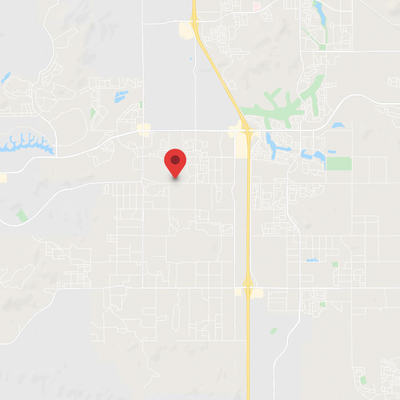
Find a Dealer.
Count on your local Caldera Spas dealer to help make your experience easy and enjoyable.

